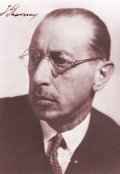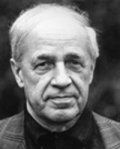
Igor Stravinsky
It was Igor Stravinsky who dragged classical music, kicking and screaming, into the twentieth century. Sure, his contemporaries had paved the way. Mahler, Strauss, Rachmaninov and Ravel had all changed music forever. No longer was the Romantic melody-rich work the dominant force. The new way was about orchestral colors and tone painting.
But it was Stravinsky who broke altogether with the Romantic past and created
Modernism. It was almost as if all the old rules had not just been bent, but completely distroyed. In the modern world, anything goes.
Stravinsky made a name for himself at a very early age. In his twenties, his work,
Fireworks brought him to the attention of Serge Diaghilev, director of the
Ballet Russes, who commissioned from Stravinsky a ballet based on the Firebird legend. It was a huge success and Diaghilev commissioned two more. The results were
Petrouchka and
The Rite of Spring.
These three, very early works defined, even invented, the
Modernist style, and they established the young Stravinsky as the pre-eminent composer of the century.
The story of the premier of
The Rite of Spring is famous. The audience was first treated to
Les Sylphides a ballet based on the music of Chopin. The
Rite of Spring was to follow. No doubt lulled into a pleasant dreamy state by the earlier work, and expecting something similarly pastoral with the
Rite, name after all about the most pelasant of seasons, they were in for a rude shock.
A clue comes from its subtitle:
Scenes from Pagan Russia. It opened with a bassoon bleating way higher than any bassoon was ever supposed to go, and then descended into 30 minutes of barbarism and pagan ritual sacrifice. The music was jarring, dissonant, difficult. The huge percussion sections pounded out primitive rhythms, and Nijinsky's provocative choreography challenged the audience's sensibilities.
From its first bars, hisses, boos and catcalls rang out from the audience, quickly countered by applause from Stravinsky's supporters. Satirical calls for a doctor were heard. Fistfights broke out and pandemonium reigned. Diaghilev tried in vain to calm the crowd by turning the houselights off and back on, no doubt adding to the confusion.
Stravinsky himself stormed out in fury, but the conductor, Pierre Monteau and his orchestra bravely played it to the end.
The Synopsis
Stravinsky's own description of his inspiration:
“I had a fleeting vision that came to me as a complete surprise ... I saw in imagination a solemn pagan rite: sage elders, seated in a circle, watching a young girl dance herself to death. They were sacrificing her to propitate the god of spring”.
Part I: The Adoration of the Earth.
The curtain rises to reveal young men and women in separate groups. Their surroundings are primitive and dominated by the dark forces of nature. At first the dances are light hearted but they slowly change to have more aggressive and savage movements. The young men take possession of the women and carry them offstage. A fight ensues until a wise old man makes peace. There is a stunned silence, then the men throw themselves on the ground in worship, rise again, and start an even more frenzied dance.
Part II: The Sacrifice.
The young women are standing on the stage near a fire, one of them will be chosen as a sacrifice to the earth. The chosen one stands alone and still in the middle of the stage after a mystic dance, and the young members of the tribe gather around her and dance in a "crescendo or brutal excitement." Finally the chosen one joins them and the dancing grows more and more violent until it climaxes and the chosen maiden falls exhausted and dies. The men then carry her over to the sacred stone and fall prostrate. The rite is over.

Pierre Boulez
Pierre Boulez is one of the twentieth century's greatest conductors. He was a champion of twentieth century music, revelling in Bartok, Varese, Ligeti and, of course, Stravinsky.
His 1969 recording of
The Rite of Spring and Petrouchka is regarded as a classic. Rarely is the frightening ferocity of the
Rite fully conveyed, and the clarity of the orchestra and CD transfer is excellent. I challenge your neck hairs to not rise on listening to this CD.
Even now, in the twentiy first century, the power of this music is unsurpassed. The
Rite is music and humanity at its most primal and confonting. The 1913 audience was completely unprepared for it, yet the First World War that followed proved what little it takes for humanity to decay into such base ferocity.
Prophetic indeed, and ahead of its time; it certainly keeps its power today.
Please support Good-Music-Guide.com
by purchasing this CD using this link.

Track Listing
Igor Stravinsky
The Rite of Spring
(Le Sacre du Printemps)
Cleveland Orchestra
Pierre Boulez
and Petrouchka
New York Philharmonic Orchestra
Pierre Boulez
Petrushka: Bulesque In Four Scenes
- The Shrove-Tide Fair
- The Charlatan's Booth
- Russian Dance
- Petrushka's Room
- The Moor's Room
- Dance Of The Ballerina
- Waltz - The Ballerina And The Moor
- The Shrove - tide Fair (towards evening) - Dance Of The Wet-Nurses
- The Bear And The Peasant
- The Jovial Merhant With Two Gypsy Girls
- Dance Of The Coachmen And Grooms
- The Masqueraders
- The Fight: The Moor And Petrushka
- Death Of Petrushka
- The Police And The Charlaten - Apparition Of Petrushka's Double
The Rite Of Spring: Scenes Of Pagan Russia In Two Parts
- Introduction - Lento
- The Augurs Of Spring (Dance Of The Young Girls)
- Mock Abduction
- Spring Round Dances
- Games Of The Rival Tribes
- Procession Of The Wise Elder
- Adoration Of The Earth (The Wise Elder)
- Dance Of The Earth
- Part II: Introduction - Largo
- Mystical Circles Of The Young Girls
- Glorification Of The Chosen Victim
- Summoning Of The Ancestors
- Ritual Of The Ancestors
- Sacrificial Dance (The Chosen Victim)